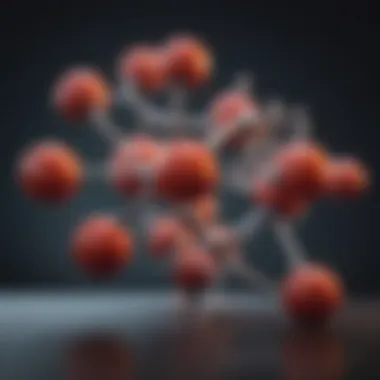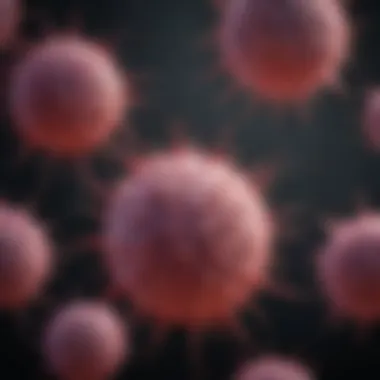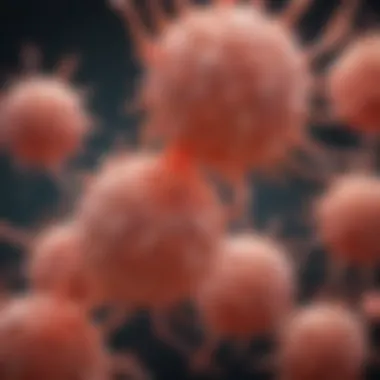Artemisinin: Emerging Role in Cancer Therapy


Intro
Artemisinin is a compound that originates from the sweet wormwood plant, known scientifically as Artemisia annua. It has captured attention in recent years for its potential application in cancer treatment. This interest stems from its unique biological properties and mechanisms of action, which may make it a promising candidate for augmenting existing cancer therapies.
The exploration of artemisinin in oncology is not merely an academic exercise; it has significant implications for patient treatment and outcomes. As traditional and modern medicine converge, understanding the role of such compounds becomes essential for clinicians and researchers alike.
This article will present a thorough analysis of current clinical trials, focusing on the efficacy, safety, and mechanisms of artemisinin in cancer therapy. The insights gained from this research are vital for advancing therapeutic options in the fight against cancer.
Intro to Artemisinin
The study of artemisinin has gained recognition as a potentially valuable component in cancer therapy. This compound, extracted from the Artemisia annua plant, originally utilized in traditional Chinese medicine, is now under scrutiny for its anticancer properties. Addressing the role of artemisinin in cancer treatment is crucial for understanding how alternative medicine can bridge the gap with contemporary oncology. Patients and practitioners alike seek effective solutions beyond conventional methods. Scholars are increasingly examining its mechanisms of action and therapeutic potential.
Historical Background
Artemisinin's history is strongly connected to traditional Chinese medicine. Qinghao, or sweet wormwood, has been used for centuries to address various ailments, particularly fevers caused by malaria. In the 1970s, the compound was isolated, and its medicinal benefits were documented systematically. Chinese scientist Tu Youyou discovered that artemisinin could reduce malaria symptoms significantly. This remarkable breakthrough has led to interest in its broader applications, specifically in cancer treatment. As research evolved, studies began to explore artemisinin's anticancer properties, leading to noteworthy results in laboratory settings.
Chemical Composition
Artemisinin's chemical structure is complex, featuring a unique peroxide bridge, which is central to its pharmacological activity. Its molecular formula is C152O5. This composition is what distinguishes artemisinin from other compounds. Understanding its structure is critical to grasping how it interacts at the cellular level. The conversion of artemisinin to dihydroartemisin and other derivatives enhances its bioavailability, leading to potent anticancer effects. The compound can generate reactive oxygen species in cancer cells, potentially leading to cell death. This connection between the chemical makeup and its impact on cellular processes underscores the importance of deeper scrutiny in clinical settings.
Mechanisms of Action in Cancer Treatment
The mechanisms through which artemisinin exhibits its anticancer properties are critical for understanding its potential role in cancer therapy. In this section, we explore the specific pathways through which artemisinin can affect tumor cells. By elucidating these mechanisms, we can better appreciate the advantages and limitations of artemisinin as an adjunct to traditional oncology approaches. Gaining insights into these processes can lead to more informed treatment strategies and eventual clinical applications.
Reactive Oxygen Species Generation
One of the primary mechanisms of action of artemisinin involves the generation of reactive oxygen species (ROS). This process occurs when artemisinin is activated in the presence of iron, which is commonly found in cancer cells. The interaction between artemisinin and iron leads to the formation of free radicals. These highly reactive species can cause oxidative damage to cellular components, including lipids, proteins, and DNA. This oxidative stress can ultimately result in cell death, particularly in neoplastic cells that are often vulnerable to such damage.
It is important to note that the levels of ROS generated and their effects can vary depending on the cellular context. In cancer cells, where oxidative stress is often elevated, the addition of artemisinin can exacerbate this condition, leading to tumor cell apoptosis (programmed cell death). Thus, the ability of artemisinin to produce ROS is a critical factor in its potential efficacy as a cancer treatment.
Inhibition of Cell Proliferation
Artemisinin also plays a role in inhibiting cell proliferation. Various studies demonstrate that artemisinin can effectively slow down or halt the growth of cancer cells. This effect is particularly significant in specific types of cancer, such as breast cancer and leukemia. The compound interferes with the cell cycle, leading to a delay in progression from one phase to another.
By targeting different phases of cell division, artemisinin can suppress the multiplication of cancer cells. Mechanistically, research indicates that artemisinin and its derivatives may disrupt the synthesis of DNA, ultimately hindering the replication capabilities of malignant cells. Furthermore, artemisinin has shown the ability to modulate signaling pathways involved in cell growth, including those linked to the ERK and PI3K/AKT pathways.
Induction of Apoptosis
Finally, artemisinin's ability to induce apoptosis is a pivotal mechanism in its anticancer effect. Apoptosis is a programmed and controlled process of cellular self-destruction. In cancer therapy, augmenting apoptosis in tumor cells can be crucial for limiting cancer progression.
Artemisinin appears to activate several apoptotic pathways in cancer cells. It activates caspases, which are enzymes essential for the execution phase of apoptosis. Additionally, artemisinin influences the expression of pro-apoptotic and anti-apoptotic proteins, thereby tipping the balance toward increased cell death in tumor tissues. It is also suggested that artemisinin's induction of apoptosis is associated with the stress responses triggered by ROS generation.
"The ability of artemisinin to trigger apoptosis in a targeted manner makes it a compelling candidate in ongoing cancer research."
Clinical Trials Overview
The overview of clinical trials in the context of artemisinin as a cancer treatment is crucial for understanding its therapeutic potential and limitations. Clinical trials serve as the backbone of modern medical research, providing systematic assessments of the efficacy and safety of new treatments. They allow researchers to evaluate how artemisinin interacts with cancer biology, its dosage parameters, and possible side effects in human subjects. This section discusses the different types of trials, highlights key results from notable studies, and assesses artemisinin's effectiveness compared to conventional cancer treatments.
Types of Trials
There are several types of clinical trials that focus on artemisinin and its derivatives in cancer treatment. Each type serves a unique purpose and adds value to overall research. The main classifications include:


- Phase I Trials: These trials primarily focus on safety. They test dosage levels and determine how the substance is metabolized in human subjects. The aim is to find out the maximum tolerated dose while monitoring for any adverse effects.
- Phase II Trials: Here, the effectiveness of artemisinin is studied in patients with specific types of cancer. These trials help to refine treatment protocols and give insight into dosage effectiveness.
- Phase III Trials: These larger studies compare artemisinin therapy against standard treatments in a randomized manner. They provide more robust data regarding efficacy and potential side effects.
- Phase IV Trials: Also known as post-marketing studies, these trials continue to monitor the drug's effectiveness and safety once it has been approved for public use.
Understanding these categories is essential in evaluating artemisinin’s clinical journey and its role in oncology.
Key Clinical Trials and Their Results
To date, several key trials have generated notable findings related to artemisinin's application in cancer treatment. Highlights include:
- Wu and colleagues' trial (2006) observed the effects of artemisinin on breast cancer cells. The study indicated a significant reduction in tumor size, suggesting that artemisinin may exhibit pronounced anti-cancer effects.
- A 2014 study published in the Journal of Integrative Medicine explored the effectiveness of artemisinin in treating hepatocellular carcinoma, noting positive outcomes in patients who received artemisinin in conjunction with traditional treatments.
- Phase II trial conducted in 2019 assessed artemisinin's effects on leukemia patients. Results indicated an increased survival rate compared to traditional therapies, emphasizing artemisinin's potential role in combinational regimens.
These trials lend credence to artemisinin’s promise in oncological practices. They underscore the necessity of further investigation to clarify its specific effects across various types of cancers.
Comparative Effectiveness with Conventional Treatments
When examining artemisinin against established cancer treatments, research has provided insightful comparisons. Generally, artemisinin demonstrates benefits such as:
- Reduced Side Effects: Traditional chemotherapies often lead to severe side effects. In contrast, artemisinin appears to be better tolerated by patients, leading to a lesser burden.
- Synergistic Effects: Research shows that when combined with conventional therapies like doxorubicin or cisplatin, artemisinin enhances anti-cancer effects, thereby improving the overall outcomes for patients.
- Targeting Specific Pathways: Artemisinin exhibits unique mechanisms of action that can interrupt cancer cell processes that conventional treatments may miss, making it a valuable addition to treatment protocols.
Key Insight: "The incorporation of artemisinin into oncological therapies could yield new avenues for treatment, particularly for cases resistant to standard therapies."
In summary, the clinical trials offer substantial evidence on the potential of artemisinin in cancer therapy, promoting the case for more extensive studies and practical applications.
Safety and Adverse Effects
The topic of safety and adverse effects is critical when assessing new therapeutic agents like artemisinin in cancer treatment. Understanding these aspects helps identify risks, manage patient expectations, and ensure overall well-being as patients explore innovative options in their treatment plans. The evaluation of safety not only encompasses potential adverse reactions but also involves monitoring long-term effects that could arise with sustained use.
Adverse Effects Observed in Trials
Clinical trials of artemisinin have reported various adverse effects, although most have been generally mild and manageable. Commonly observed issues include:
- Gastrointestinal symptoms: Nausea and diarrhea are frequently reported by patients, which can affect treatment adherence.
- Neurological effects: Dizziness and headaches are noted, potentially impeding daily routines for patients undertaking treatment.
- Allergic reactions: Though rare, some patients have experienced allergic responses, emphasizing the necessity of medical oversight during treatment.
Despite these concerns, the overall tolerance towards artemisinin appears favorable when weighed against its potential benefits in reducing tumor growth and promoting cancer cell apoptosis. Monitoring patients closely during clinical trials is essential to ensure these side effects are effectively managed, thus maintaining the integrity of the study outcomes.
Long-term Safety Considerations
Long-term safety considerations are paramount when contemplating the incorporation of artemisinin into cancer treatment protocols. While short-term clinical trials provide valuable insights, the long-term impact of artemisinin usage remains less clear. Key points to consider include:
- Cumulative exposure risks: Extended use could reveal unforeseen adverse effects, necessitating ongoing studies that track patient health over years.
- Interactions with conventional treatments: It is crucial to understand how artemisinin interacts with other medications commonly used in cancer therapy, as unforeseen toxicities may arise.
- Patient population variability: Different demographics may respond distinctively to artemisinin, making inclusive research essential to highlight which populations can safely utilize this compound.
Longitudinal studies will play a significant role in addressing these issues and establishing clear safety profiles for artemisinin in cancer treatment. Rigorous pharmacovigilance must be maintained to not only protect patients but also guide future research in this promising area.
Comparative Analysis: Artemisinin vs. Other Anti-Cancer Agents
The comparative analysis of artemisinin and other anti-cancer agents is essential in understanding its potential role in oncology. This section will cover how artemisinin can work in synergy with conventional treatments, as well as insightful mechanistic comparisons. By examining these factors, we can assess the additive value that artemisinin brings to the table, especially given the growing interest in personalized medicine and integrative approaches to cancer therapy.
Synergy with Conventional Chemotherapy
Artemisinin has shown promise when combined with conventional chemotherapy drugs. The combination therapies aim to enhance the effectiveness of chemotherapy while minimizing adverse effects. Clinical studies, for example, have indicated that artemisinin can potentiate the cytotoxic effects of well-known drugs such as doxorubicin and cisplatin. These findings suggest that artemisinin may improve treatment outcomes by enhancing drug activity in cancer cells.
Moreover, one of the advantages of using artemisinin is its distinct mechanism of action. While conventional chemotherapy primarily targets rapidly dividing cells, artemisinin influences the tumor microenvironment through different pathways. This can lead to a more effective therapeutic index.


Some key points to consider about synergy include:
- Enhanced Efficacy: The combination can intensify the cancer cell kill rate.
- Reduced Drug Resistance: Artemisinin may help counteract drug resistance mechanisms that cancer cells develop.
- Improved Patient Outcomes: Combined use can lead to better prognosis and survival rates in some patient populations.
Mechanistic Comparisons
When evaluating the mechanistic actions of artemisinin in contrast to other anti-cancer agents, significant differences emerge. Conventional agents often focus on disrupting the DNA replication process or damaging cellular structures essential for division. In contrast, artemisinin's principal action hinges on the formation of reactive oxygen species (ROS) within cancer cells, leading to oxidative stress and subsequent apoptosis.
Key mechanistic insights include:
- Mechanism of Action: Unlike common cytotoxic agents, which may distribute unevenly in the body or require precise dosing, artemisinin appears to provoke a more systematic effect on cancer cells.
- Selectivity: Artemisinin has shown selective toxicity towards cancer cells while sparing normal cells, which is a desirable feature in cancer therapy.
- Resistance Profiles: Conventional agents often face the issue of acquired drug resistance. Artemisinin may provide an alternative approach that could be less susceptible to these resistance pathways.
Overall, the comparative analysis showcases that while artemisinin offers unique advantages, its role in cancer treatment should be further explored through rigorous clinical trials to understand fully the potential benefits and limitations in real-world applications.
Future Directions in Research
The exploration of artemisinin in cancer therapy represents a significant frontier in oncological research. Identifying future directions is essential for capitalizing on the compound's potential. By focusing on emerging areas of study and the possible for combination therapies, researchers can refine treatment strategies and improve patient outcomes. Addressing these new avenues will play a crucial role in establishing artemisinin as a prominent choice in cancer treatment.
Emerging Areas of Study
Several promising areas warrant further investigation concerning artemisinin's applications. Researchers are examining its efficacy against various cancer types. Notably, studies are indicating potential effectiveness in colorectal, breast, and pancreatic cancers. Each cancer type presents distinct cellular environments and reactions to treatment, highlighting the need for tailored therapeutic strategies.
Another area of focus involves the investigation of artemisinin derivatives. These compounds may exhibit enhanced potency or altered pharmacokinetics. For example, artesunate and artemether are already being evaluated for their potential benefits in oncology. Understanding the nuances of these derivatives could unlock new therapeutic pathways.
Furthermore, research into the pharmacogenomics of artemisinin is increasingly crucial. Given the variability in individual tumor biology and genetics, tailoring treatments based on genetic markers can optimize efficacy. This personalized approach aligns with current trends in oncology, aiming to customize therapies to patient-specific characteristics.
Potential for Combination Therapies
The integration of artemisinin with conventional chemotherapy is emerging as a vital research avenue. Evidence suggests that artemisinin may enhance the effects of standard treatments, improving overall survival rates and reducing adverse effects. For instance, pairing artemisinin with agents like doxorubicin or cisplatin demonstrates potential synergistic effects. This combination could allow for lower dosages of conventional drugs, thus minimizing toxicity.
Moreover, exploring artemisinin's role in immunotherapy is gaining traction. The compound may influence immune responses, potentially boosting the effectiveness of immune checkpoint inhibitors. Combining artemisinin with treatments like pembrolizumab could lengthen progression-free survival in certain patients.
Further studies are needed to establish the optimum dosages and timing for combination therapies. The rationale is to identify effective regimens while maintaining safety profiles. Researchers should also consider phase I and II clinical trials to assess these combinations rigorously.
Ethical Considerations in Clinical Trials
Ethical considerations play a crucial role in the design and implementation of clinical trials involving artemisinin. The integrity of research and the welfare of participants are paramount. Without addressing ethical concerns, the legitimacy of findings can be compromised. This section will delve into the key areas of focus such as informed consent practices and regulatory oversight, integral to ensuring the ethical dimensions of any clinical investigation.
Informed Consent Practices
Informed consent is an essential component in clinical trials. It ensures that participants fully understand the nature of the study, including its potential risks and benefits. For trials involving artemisinin, clear communication is vital due to its experimental status in oncology. Participants must receive comprehensive information about the drug, the trial process, and possible side effects.
In practice, informed consent involves several steps:
- Clear explanations of the study objectives.
- Detailed discussion of risks associated with artemisinin, including possible adverse effects.
- Clarity on participants' right to withdraw from the trial at any time without penalty.
Researchers must present this information in a manner that is accessible, considering the educational background and language proficiency of participants. This process builds trust and ensures that individuals are not only participants but partners in the research endeavor.
Regulatory Oversight
Regulatory bodies play a significant role in safeguarding ethics during clinical trials. In the context of artemisinin research, oversight ensures that studies comply with international ethical standards. Regulatory agencies evaluate trial protocols, ensuring they align with guidelines that protect participants’ rights and well-being.


Key aspects of regulatory oversight include:
- Review of clinical trial applications to ensure ethical rigorousness.
- Monitoring trial conduct to catch any deviations from approved protocols.
- Protection measures for vulnerable populations, ensuring they are adequately safeguarded.
These regulatory frameworks are essential for maintaining the credibility of the research process. They provide necessary checks and balances, helping to ensure that artemisinin's potential benefits can be realized without compromising participant welfare.
"Ethical clinical research protects both the integrity of the scientific inquiry and the rights and safety of participants."
Implications for Clinical Practice
The integration of artemisinin in cancer treatment presents significant implications for clinical practice. This compound is gaining attention not only for its potential anticancer properties but also for its unique mechanism of action. Understanding how artemisinin can complement existing treatment protocols is essential for oncologists and healthcare professionals. Furthermore, addressing the safety profiles and potential adverse effects associated with artemisinin can help clinicians make informed treatment decisions.
Integration into Treatment Protocols
Incorporating artemisinin into cancer treatment protocols requires careful consideration of various factors. This includes understanding dosage, administration methods, and patient-specific factors such as age, cancer type, and health status. Given artemisinin’s unique therapeutic properties, it could be considered as a complimentary therapy alongside conventional treatments like chemotherapy and radiation.
The evidence from recent clinical trials suggests that artemisinin could enhance the efficacy of these conventional treatments while potentially reducing associated side effects. Oncology practitioners should assess individual patient conditions to determine optimal integration strategies. Protocols may include:
- Combination therapies: Using artemisinin with established chemotherapeutic agents to improve overall treatment outcomes.
- Tailored treatment plans: Adjusting doses based on patient's response to treatment and tolerability.
- Monitoring: Regularly assessing patient health to identify any adverse effects that may arise from combined treatments.
Patient Education and Awareness
Educating patients about the role and benefits of artemisinin in their cancer treatment is crucial. Patients must understand not only how artemisinin works but also the possibilities it presents for their specific condition. This education can lead to better adherence to treatment protocols and improved patient outcomes.
Healthcare providers should focus on:
- Clear communication: Explaining the science behind artemisinin in a way that is easy for patients to understand.
- Informed decision-making: Encouraging patients to actively participate in their treatment plans, including understanding the complementary nature of artemisinin and conventional therapies.
- Addressing concerns: Providing information about potential side effects and the importance of monitoring health during treatment.
"Patient education is a key component in the successful implementation of any new treatment regimen."
Empowering patients with knowledge can enhance their treatment experience, leading to better outcomes. As research evolves, ongoing education will be necessary to keep both providers and patients informed about the latest findings concerning artemisinin and its application in cancer care.
Epilogue
The conclusion of this article holds significant importance. It reinforces the central concepts explored throughout the analyses of artemisinin's potential in cancer treatment. This section synthesizes the significant findings from various clinical trials, emphasizing the therapeutic promise of artemisinin against numerous types of cancer.
Summary of Findings
Research reveals that artemisinin exhibits unique mechanisms that enhance its anti-cancer properties. Studies have shown that it generates reactive oxygen species which induce cellular stress, effectively inhibiting tumor growth and proliferation. Furthermore, this compound facilitates apoptosis, or programmed cell death, in cancer cells. The evidence suggests that patients consuming artemisinin, either alone or in combination with traditional treatments, may experience improved outcomes. Additionally, compared to conventional chemotherapy, artemisinin displays a better side-effect profile, exhibiting lower toxicity levels. Collectively, these findings present a compelling case for artemisinin as a valuable addition to cancer treatment protocols, promoting a shift towards integrating traditional and modern therapies.
"The integration of artemisinin into cancer treatment presents an opportunity to improve efficacy while reducing harmful side effects."
The Future of Artemisinin Research
Looking ahead, the future of artemisinin research remains vibrant and full of potential. As scientists continue to investigate its efficacy, there is a burgeoning interest in exploring combination therapies. These may include synergistic impacts with existing chemotherapy regimens or novel drug formulations. Emerging areas such as personalized medicine could tailor artemisinin-based therapies to specific patient profiles, potentially enhancing outcomes.
Moreover, ongoing clinical trials are essential for addressing safety concerns and establishing standardized dosages. Such development is crucial to validate the benefits that artemisinin can offer in diverse populations with various cancer types.
In summary, the journey with artemisinin in cancer treatment is far from complete. The integration of this compound could pave new ways for therapeutic strategies in oncology, fostering collaboration between traditional remedies and modern medical practices.
Key Literature in the Field
A diverse body of literature informs the discussion of artemisinin's potential in oncology. Significant works to consider include:
- Tu, Y. (2011). The discovery of artemisinin, a key development in treating malaria that highlights its potential application in oncology.
- Huang, S., et al. (2015). A clinical trial that studies the cytotoxic effects of artemisinin in certain cancer cell lines, demonstrating promising results.
- Wang, H., et al. (2017). This review article outlines the mechanisms through which artemisinin induces apoptosis, offering insights into its possible use as an anti-cancer agent.
- Zhang, S., et al. (2019). A meta-analysis evaluating the effectiveness of artemisinin derivatives compared to traditional chemotherapy agents in various cancers.
In summary, integrating reputable scholarly references not only solidifies the arguments presented in this article but also assists professionals, researchers, and students in navigating the nuanced landscape of artemisinin research. With these references, the discourse surrounding artemisinin's role in cancer treatment is both richer and more reliable.















